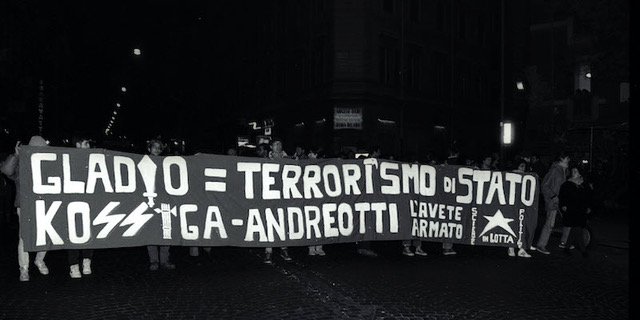
Student protest in Rome on Dec. 12, 1990, anniversary of the Piazza Fontana massacre. Banner reads Gladio = State sponsored terrorism. Source: Il Post.
By Cym Gomery, Montréal for a World BEYOND War, May 24, 2023
First published by The Canada Files.
On April 21, 2023, the French Court of Assize declared Palestinian-Canadian professor Hassan Diab guilty of the 1980 rue Copernic bombing in Paris, despite proof that he was not in France at that time, but in Lebanon taking sociology exams.
Once again, mild-mannered Professor Hassan Diab stands to be extradited to France. The media seems to be polarized on this issue—many mainstream media journalists are shouting – Off with his head! – as the progressive media steadfastly repeat the facts of this case, as if the truth, repeated often enough, could somehow sway the courts.
This drama has been in the news since 2007, when Diab learned that he was accused of the rue Copernic bombing from a Le Figaro reporter. He was arrested in November 2008, faced Evidentiary Hearings in late 2009 and committed to extradition in June 2011, despite a “weak case.” The ordeal continued:
-
November 14, 2014: Diab was extradited to France and imprisoned;
-
November 12, 2016: French Investigative judge finds “Consistent Evidence” supporting Diab’s innocence;
-
November 15, 2017: Even though French Investigative Judges had ordered Diab’s release eight times, Appeal Court overturned the last (eighth) Release Order;
-
January 12, 2018: French Investigative judges dismissed allegations; Diab released from prison in France;
Now, in 2023, French prosecutors made the surprising decision to try Diab in absentia. An equally astonishing guilty verdict has resurrected the specter of extradition and reminded us that there are many unsolved questions. Diab has always proclaimed his innocence. All the evidence provided by French prosecutors has been refuted, time and again.
Why is the French government so hell-bent on getting this case closed, and its one-and-only suspect behind bars? Why has there never been any investigation to find the real perpetrator of the bombing?
An examination of other crimes around the time of the rue Copernic bombing suggests that the French government and other actors may have dark motives for pursuing a scapegoat.
The rue Copernic bombing
At the time of the rue Copernic synagogue bombing (October 3, 1980), newspapers stated that an anonymous caller had blamed the attack on a known anti-Semitic group, the Faisceaux nationalistes Européans. However, the FNE (formerly known as FANE) denied responsibility hours later.
The story of the bombing elicited generalized outrage in France, but even after months of investigations, Le Monde reported that there were no suspects.
The rue Copernic bombing was part of a pattern of similar attacks around that time in Europe:
Just two months earlier, on August 2, 1980, a bomb in a suitcase in Bologna, Italy exploded, killing 85 people and wounding more than 200 [1]. The US military style bomb used was similar to explosives that the Italian police had found in one of Gladio’s arms dumps near Trieste. Members of the Nuclei Armati Rivoluzionary (NAR), a violent Neo-fascist group, were present at the explosion and were among the injured. Twenty-six NAR members were arrested but were later released due to the intervention of SISMI, Italy’s military agency.
-
On September 26, 1980, a pipe bomb exploded at the Munich Oktoberfest, killing 13 people and injuring more than 200 others. [2]
-
On November 9, 1985, shots rang out at the Delhaize supermarket in Belgium, one of a series of events between 1982 and 1985 known as the Brabant massacres that left 28 people dead. [3]
-
The killers have never been identified in these terror attacks, and evidence has been destroyed in some cases. A look at the history of Gladio stay-behind armies helps us to connect the dots.
How the Gladio stay-behind armies came to Europe
After World War II, the communists were becoming very popular in Western Europe, especially in France and Italy [4]. This raised red flags for the Central Intelligence Agency (CIA) in the US, and inevitably for the Italian and French governments. French Prime Minister Charles De Gaulle and his Socialist Party had to cooperate with the US or risk losing vital Marshall plan economic aid.
De Gaulle initially promised the communist party members (PCF) fair treatment in his government, but the PCF parliamentary members’ advocacy for “radical” policies like cuts to the military budget led to tensions between them and De Gaulle’s French Socialists.
The first scandal (1947)
In 1946, the PCF boasted about one million members, wide readership of its two daily newspapers, plus control of youth organizations and labour unions. The rabidly anti-communist US and its secret service decided to initiate a secret war on the PCF, code-named “Plan Bleu.” They succeeded in ousting the PCF from the French cabinet. However, the Plan Bleu anti-communist plot was revealed by Socialist Minister of the Interior Edouard Depreux in late 1946 and was closed down in 1947.
Unfortunately, the secret war against the Communists did not end there. French Socialist Prime Minister Paul Ramadier organized a new secret army under the purview of the Service de documentation extérieure et de contre-espionnage (SDECE) [5]. The secret army was rebranded ‘Rose des Vents’– a reference to the star-shaped official symbol of the NATO—and trained to undertake sabotage, guerrilla and intelligence-gathering operations.
The secret army goes rogue (1960s)
With the war for Algerian independence in the early 1960s, the French government began to mistrust its secret army. Even though De Gaulle himself supported Algerian independence, in 1961, the secret soldiers did not [6]. They dropped any pretense of collaboration with the government, adopting the name l’Organisation de l’armée secret (OAS), and began assassinating prominent government officials in Algiers, carrying out random murders of Muslims, and raiding banks [7].
The OAS may have used the Algerian crisis as a ”shock doctrine” opportunity to commit violent crimes that were never part of its original mandate: to defend against a Soviet invasion. Democratic institutions like the French parliament and the government had lost control of the secret armies.
SDECE and the SAC discredited, but elude justice (1981-82)
In 1981, the SAC, a secret army established under De Gaulle, was at the height of its powers, with 10,000 members comprising the police, opportunists, gangsters, and people with extreme right-wing views. However, the gruesome murder of a former SAC police chief Jacques Massif and his entire family in July 1981, spurred newly elected President Francois Mitterand to initiate a parliamentary investigation of the SAC [8].
Six months of testimony revealed that the actions of the SDECE, SAC and the OAS networks in Africa were ‘intimately linked’ and that the SAC had been financed through SDECE funds and drug trafficking [9].
Mitterand’s investigative committee concluded that the SAC secret army had infiltrated the government and had carried out acts of violence. Intelligence agents, “driven by Cold War phobias” had broken the law and had accumulated a plethora of crimes.
Francois Mitterand’s government ordered the SDECE military secret service to be disbanded, but this did not occur. The SDECE was merely rebranded as the Direction Generale de la Securité Extérieure (DGSE), and Admiral Pierre Lacoste became its new Director. Lacoste continued to run the secret army of the DGSE in close cooperation with NATO [10].
Perhaps the most notorious action of the DGSE was the so-called ”Operation Satanique:” On July 10, 1985, secret army soldiers bombed the Greenpeace vessel Rainbow Warrior that had protested peacefully against French atomic testing in the Pacific [11] . Admiral Lacoste was forced to resign after the crime was traced back to the DGSE, Defence Minister Charles Hernu and President Francois Mitterand himself.
In March 1986, the political right won the parliamentary elections in France, and Gaullist Prime Minister Jacques Chirac joined President Mitterrand as head of state.
1990: The Gladio scandal
On August 3, 1990, Italian prime minister Giulio Andreotti confirmed the existence of a secret army code-named “Gladio” – the Latin word for “sword” – within the state. His testimony before the Senate subcommittee investigating terrorism in Italy shocked the Italian parliament and the public.
The French press revealed then that the French secret army soldiers had been trained in the use of arms, the manipulation of explosives, and the use of transmitters in various remote sites in France.
However, Chirac was probably less than eager to see the history of the French secret army investigated, having himself been president of the SAC back in 1975 [12]. There was no official parliamentary investigation, and while Defence Minister Jean Pierre Chevenement reluctantly confirmed to the press that secret armies had existed, he intimated that they were a thing of the past. However, Italian Prime Minister Giulio Andreotti later informed the press that representatives of the French secret army had taken part in the Gladio Allied Clandestine Committee (ACC) meeting in Brussels as recently as October 24, 1990—an embarrassing revelation for French politicians.
1990 to 2007—NATO and the CIA in damage control mode
The Italian government took a decade, from 1990 to 2000, to complete its investigation and issue a report which specifically implicated the US and the CIA in various massacres, bombings and other military actions.
NATO and the CIA refused to comment on these allegations, at first denying having ever undertaken clandestine operations, then retracting the denial and refusing further comment, invoking “matters of military secrecy”. However, former CIA director William Colby broke rank in his memoirs, confessing that setting up the secret armies in Western Europe had been “a major program” for the CIA.
Motive and precedent
If they were mandated to only fight communism, why would the Gladio stay-behind armies carry out so many attacks on ideologically diverse innocent civilian populations, like the Piazza Fontana bank massacre (Milan), the Munich Octoberfest massacre (1980), the Belgium supermarket shooting (1985)? In the video “NATO’s secret armies”, insiders suggest that these attacks are meant to manufacture public consent for increased security and continuing the cold war. The Brabant massacres, for example, coincided with anti-NATO protests in Belgium at that time, and the Greenpeace Rainbow Warrior was bombed as it protested French atomic testing in the Pacific.
The rue Copernic synagogue bombing, although not about quashing dissent for nuclear war, was consistent with the CIA’s “strategy of tension” peacetime terrorism.
The perpetrators of attacks like the Piazza Fontana massacre in Milan 1980, the Munich Oktoberfest bomb in 1980, and the Delhaize supermarket shooting in Belgium in 1985, have never been found. The rue Copernic Synagogue bombing displays the same modus operandi, the only difference being that the French government has doggedly insisted on pursuing a conviction for this particular crime.
The French government’s historical collaboration with the Gladio secret armies may be why, even today, the government would prefer to prevent the public from getting too curious about unsolved terrorist attacks in Europe.
NATO and the CIA, as violent entities whose very existence depends on war, have no interest in seeing a multipolar world in which diverse groups enjoy harmonious coexistence. They, together with various French government officials, have a clear motive for pursuing a scapegoat to help them bury the rue Copernic case.
With nuclear war a very real possibility, solving this crime could have global implications and repercussions. For, as one witness in the documentary Operation Gladio-NATO’s Secret Armies remarked, “If you discover the killers, you probably also discover other things.”
References
[1] Nato’s Secret Armies, page 5
[2] Nato’s Secret Armies, page 206
[3] Ibid, page
[4] Ibid, page 85
[5] NATO’s Secret Armies, page 90
[6] Ibid, page 94
[7] Ibid, page 96
[8] Ibid, page 100
[9] Ibid, page 100
[10] Ibid, page 101
[11] Ibid, page 101
[12] Ibid, page 101
Editor’s note: The Canada Files is the country’s only news outlet focused on Canadian foreign policy. We’ve provided critical investigations & hard-hitting analysis on Canadian foreign policy since 2019, and need your support.








